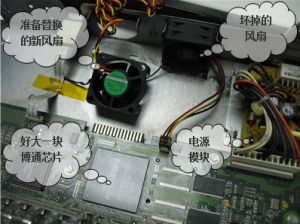网上买了一只二手的二十四口铁盒子2950交换机,成色还不错,拆开看了下(太好拆了,我本来以为会很难拆的),出厂日期是二零零六年,线路板完好,电源模块成色也很新,就是灰尘多了点,风扇声音巨~~~大,看样子风扇是快要坏了,相当幸运的是,这个风扇的型号和以前公司遗留下来的服务器风扇一模一样,于是我很简单的就把新的风扇换了上去,运作顺畅,清理了一下灰尘,嗯,这一转手卖个七八百应该不成问题,接下来就是升级交换机的操作系统,也就是著名的IOS(Internetwork Operating System),铁盒子公司一直声称他们是卖软件的,我觉得好像也是,交换机里面的芯片不是英特尔就是博通,接口不是安普就是欧姆龙,除了铁盒子外面写了个cisco systems,就木有哪里有标志了。

下面我们来升级2950的IOS,准备工作:在我得电脑上开启tftpd服务,下载最新版本的2950IOS。
铁盒子屁股上写了个出厂IOS版本号EA1B,登录进去系统看看,果然是c2950-i6q4l2-mz.121-22.EA1b.Bin,说明这个铁盒子从来没有升级过,首先我们需要备份一下原来的IOS,万一升级失败了也好恢复,在CLI里面命令如下:
copy flash:/c2950-i6q4l2-mz.121-22.EA1b.Bin tftp
然后输入你电脑的IP地址就可以了,在几十秒钟后,电脑上tftpd的目录就可以看到传输过来的旧版IOS了。
如果配置文件中加了很多选项,那么最好也备份下config.Txt,步骤雷同。
接下来删除html管理器的目录,如果你不需要通过http来进行管理的话,也是要删除的,因为要删除了才能不通过它来管理嘛,如果不删除,那就是旧版本的html管理器配上新版本的IOS,那可不一定会发生什么神奇的事情,在CLI里面命令如下:
delete /r flash:/html
然后确认就可以了。
接下来检查一下剩余的flash空间,一般来说2950交换机的flash空间都比较小,只有八个MB,而新的IOS最小也有四个MB,我下载带加密功能的新版IOS(c2950-i6k2l2q4-tar.121-22.EA13.tar)有五点六个MB,所以,我们必须要删除原有IOS才能安装新的IOS,你看像现在新的2960交换机,flash有两百五十六个MB,可以放好多个不同的IOS哦~那么,删除旧版IOS的命令如下:
delete flash:/c2950-i6q4l2-mz.121-22.EA1b.Bin
到这一步,你就千万不能断电了,要是断电了,嘿嘿,哈哈,该贝斯。
接下来我们把新的IOS通过tftp协议传输到交换机上,例如我开启tftpd电脑的IP地址是192.168.1.99,然后在CLI里面命令如下:
archive tar /xtract tftp://192.168.1.99/c2950-i6k2l2q4-tar.121-22.EA13.tar flash:
接下来交换机会解压缩tar包,将bin文件放到根目录,将html管理器解压缩到根目录,直到重新出现#号提示符,IOS升级完成,然后我们需要重启一下交换机,看是否真正升级成功,在命令行下输入reload即可。
再次登录进入交换机,我们输入命令查看一下系统版本信息,可以看到,操作系统已经成功升级为Version 12.1(22)EA13带cryptographic功能的IOS。
c2950>sh ver
Cisco Internetwork Operating System Software
IOS ™ C2950 Software (C2950-I6K2L2Q4-M), Version 12.1(22)EA13, RELEASE SOFTWARE (fc2)
Technical Support: http://www.cisco.com/techsupport
Copyright (c) 1986-2009 by cisco Systems, Inc.
Compiled Fri 27-Feb-09 22:20 by amvarma
Image text-base: 0×80010000, data-base: 0×80680000
ROM: Bootstrap program is C2950 boot loader
c2950 uptime is 3 hours, 44 minutes
System returned to ROM by power-on
System restarted at 11:31:18 Taipei Wed Apr 14 2010
System image file is “flash:/c2950-i6k2l2q4-mz.121-22.EA13.bin”
This product contains cryptographic features and is subject to United
States and local country laws governing import, export, transfer and
use. Delivery of Cisco cryptographic products does not imply
third-party authority to import, export, distribute or use encryption.
Importers, exporters, distributors and users are responsible for
compliance with U.S. and local country laws. By using this product you
agree to comply with applicable laws and regulations. If you are unable
to comply with U.S. and local laws, return this product immediately.
A summary of U.S. laws governing Cisco cryptographic products may be found at:
http://www.cisco.com/wwl/export/crypto/tool/stqrg.html
If you require further assistance please contact us by sending email to
[email protected].
cisco WS-C2950-24 (RC32300) processor (revision R0) with 19912K bytes of memory.
Processor board ID FOC0903T099
Last reset from system-reset
Running Standard Image
24 FastEthernet/IEEE 802.3 interface(s)
32K bytes of flash-simulated non-volatile configuration memory.
Base ethernet MAC Address: 00:13:1A:50:2B:00
Motherboard assembly number: 73-5781-13
Power supply part number: 34-0965-01
Motherboard serial number: FOC0902454E
Power supply serial number: DAB0851NHZ0
Model revision number: R0
Motherboard revision number: A0
Model number: WS-C2950-24
System serial number: FOC0903T099
Configuration register is 0xF
总的来说,铁盒子的效率比TP-LINK这样的家用产品要高,一百个MB的网络,传输速度一度可以达到20M/s,完全不符合规律。